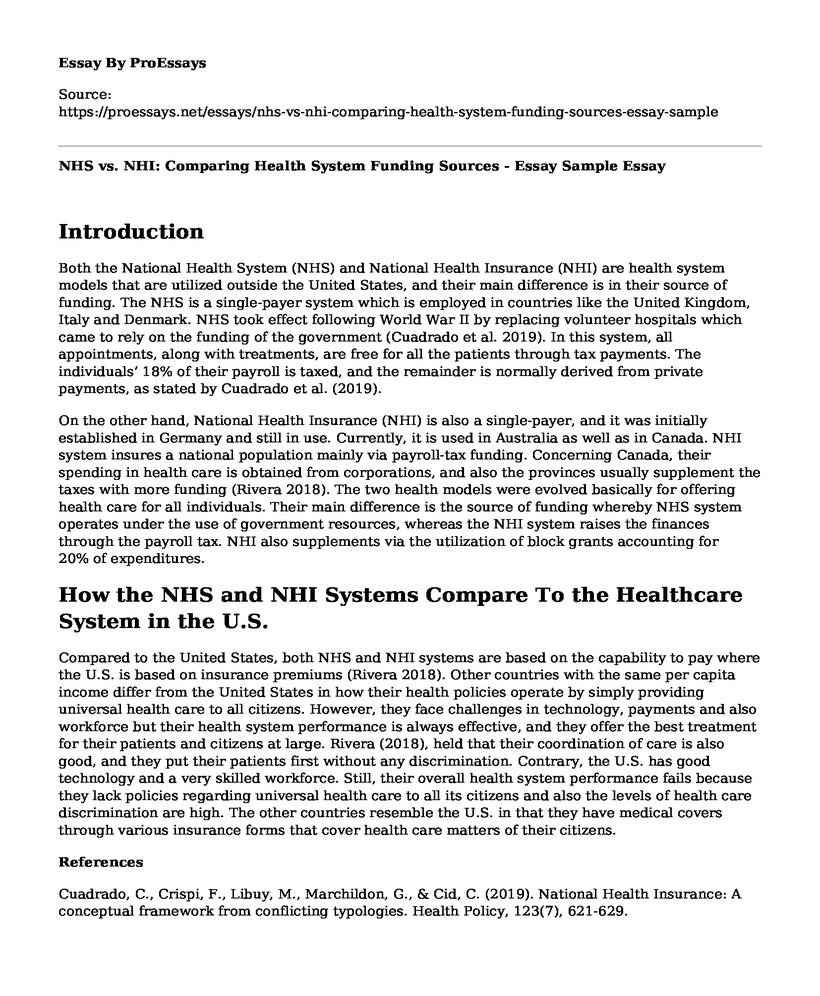Introduction
Both the National Health System (NHS) and National Health Insurance (NHI) are health system models that are utilized outside the United States, and their main difference is in their source of funding. The NHS is a single-payer system which is employed in countries like the United Kingdom, Italy and Denmark. NHS took effect following World War II by replacing volunteer hospitals which came to rely on the funding of the government (Cuadrado et al. 2019). In this system, all appointments, along with treatments, are free for all the patients through tax payments. The individuals’ 18% of their payroll is taxed, and the remainder is normally derived from private payments, as stated by Cuadrado et al. (2019).
On the other hand, National Health Insurance (NHI) is also a single-payer, and it was initially established in Germany and still in use. Currently, it is used in Australia as well as in Canada. NHI system insures a national population mainly via payroll-tax funding. Concerning Canada, their spending in health care is obtained from corporations, and also the provinces usually supplement the taxes with more funding (Rivera 2018). The two health models were evolved basically for offering health care for all individuals. Their main difference is the source of funding whereby NHS system operates under the use of government resources, whereas the NHI system raises the finances through the payroll tax. NHI also supplements via the utilization of block grants accounting for 20% of expenditures.
How the NHS and NHI Systems Compare To the Healthcare System in the U.S.
Compared to the United States, both NHS and NHI systems are based on the capability to pay where the U.S. is based on insurance premiums (Rivera 2018). Other countries with the same per capita income differ from the United States in how their health policies operate by simply providing universal health care to all citizens. However, they face challenges in technology, payments and also workforce but their health system performance is always effective, and they offer the best treatment for their patients and citizens at large. Rivera (2018), held that their coordination of care is also good, and they put their patients first without any discrimination. Contrary, the U.S. has good technology and a very skilled workforce. Still, their overall health system performance fails because they lack policies regarding universal health care to all its citizens and also the levels of health care discrimination are high. The other countries resemble the U.S. in that they have medical covers through various insurance forms that cover health care matters of their citizens.
References
Cuadrado, C., Crispi, F., Libuy, M., Marchildon, G., & Cid, C. (2019). National Health Insurance: A conceptual framework from conflicting typologies. Health Policy, 123(7), 621-629.
Rivera, D. (2018). The Relationship Between the Structure of the Healthcare System and Health Inequalities: A Comparative Analysis of 21 Developed Countries.
Cite this page
NHS vs. NHI: Comparing Health System Funding Sources - Essay Sample. (2023, Aug 23). Retrieved from https://proessays.net/essays/nhs-vs-nhi-comparing-health-system-funding-sources-essay-sample
If you are the original author of this essay and no longer wish to have it published on the ProEssays website, please click below to request its removal:
- Paper Example on Poverty and Effects On Child and Family
- Snake Venom and Treatment of Cancer Essay
- Comparing Articles on Nuclear Weapons Essay Example
- Quality Measures: Tools for Quality Health Care Services - Essay Sample
- Essay Example on Nurse's Biases and Attitudes Towards Incarcerated Individuals
- Essay Example on Education & Health Promotion: Skills, Politics & More
- Essay Sample on Achieving Good Health: Essential for All Nations







